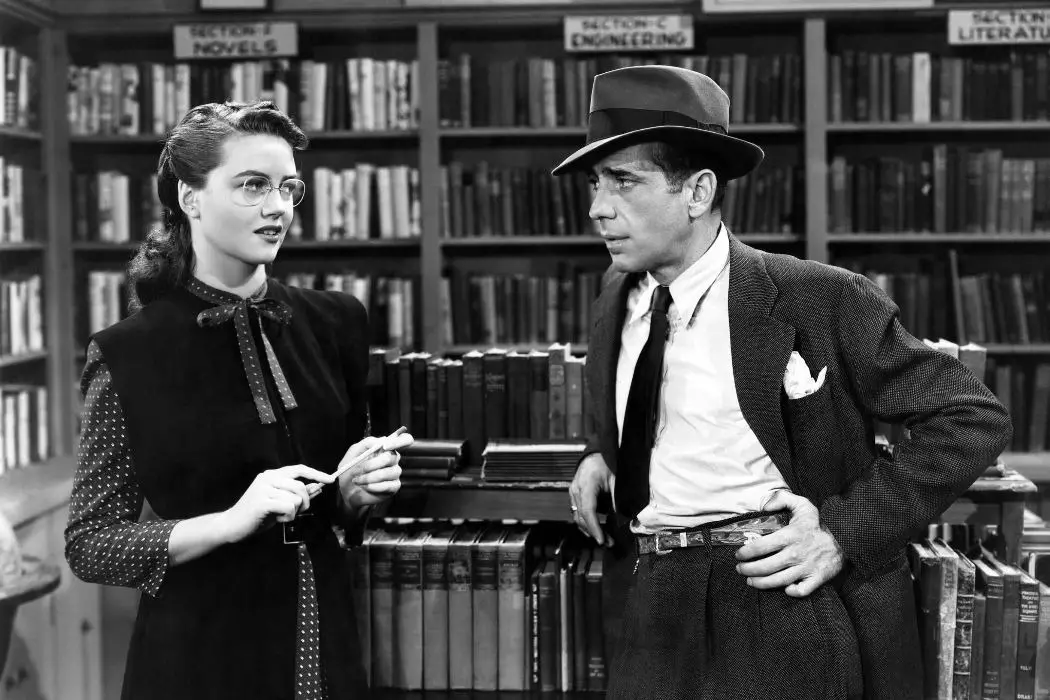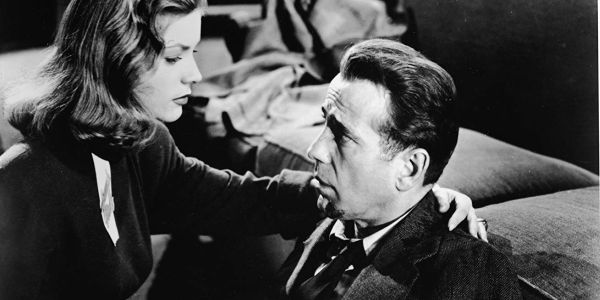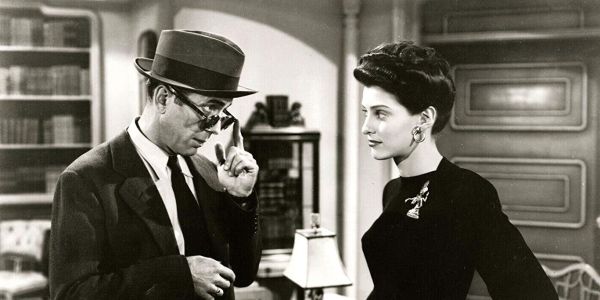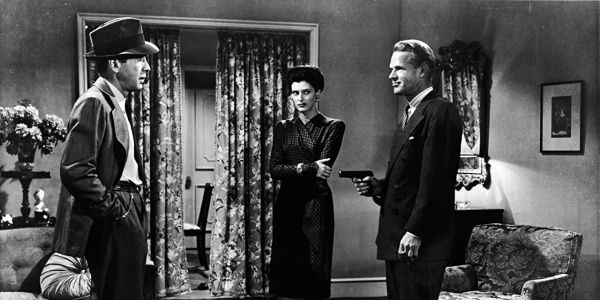How THE BIG SLEEP Made Detectives Postmodern

Danny Anderson teaches English at Mount Aloysius College in PA.…
I doubt I’ll ever forget the first time I saw Howard Hawks‘ classic 1946 film The Big Sleep, starring Humphrey Bogart and Lauren Bacall. I was attending a tiny religious college that offered little to do on the weekends. A nearby college (a rather elite one) showed free movies on its campus so I would frequently sneak in and lose myself in the forbidden fruit of cinema for a couple of hours. This remains the largest part of my education that actually stuck.
I had never heard of The Big Sleep, so when I sat down in the dim theater, I was utterly unprepared and found myself swept away by the pure style of Film Noir, and Bogart’s Philip Marlowe was the coolest image of a person I’d ever seen. I use the word “image” purposefully. In my many subsequent viewings of the film, I’ve come to understand it as almost nothing but images. Who is it about? Irresistible images. What happens onscreen? Dreamlike images. Who are its villains? Cold, heartless images.
The film, based on a novel by Raymond Chandler and which credits William Faulkner on the screenplay, remains an enigma. Even upon repeated viewings, the plot remains rather unclear, to the point where it’s not entirely obvious what the original crime is. Nor is it really that important. This is particularly jarring for the detective genre, which is normally focused on taking the murky and making it clear. The Big Sleep isn’t really very interested in finding truth.
What it is interested in is basking in the image of the detective. If films like The Maltese Falcon defined what a detective story looked like (while finding the truth), The Big Sleep runs with that image and revels in it with little regard for truth (no “just the facts, ma’am” here). The plot is little more than an excuse to roll out an endless line of fedoras, dangerous femme fatales, and guns.
If one way to understand postmodernism is as art that basks in the surfaces of things, no longer interested in finding meaning, then The Big Sleep is a film that predicts this artistic movement two decades in advance. If The Maltese Falcon is a work of high Modernism, then The Big Sleep has more in common with Postmodernism, with an obsession with the simulacrum of detective stories, not the quest for truth.
Something Like A Plot Summary
Essays such as this typically feature a plot summary, which I will now attempt. Private detective Philip Marlowe is summoned to the elderly and worldly General Sternwood’s mansion and tasked with investigating whoever is blackmailing his youngest daughter Carmen over her gambling debts. Before he leaves the premises, he is pulled aside by Sternwood’s eldest daughter Vivian Rutledge (Lauren Bacall) who eventually asks Marlowe to find the family’s missing chauffeur, Shawn Regan.
At some point, an antique dealer who is also a blackmailer gets murdered and somebody runs off with somebody’s wife. Along the way, there is the gambler Eddie Mars, a con man named Joe Brody, and a little man who follows Marlow named Harry Jones (played by the iconic character actor Elisha Cook Jr.). In the end, Bogie either outsmarts or out-toughs everyone else and falls into the arms of Bacall.

The difficulty in summarizing the plot is the point. Detective stores, since the times of Poe and Arthur Conan Doyle, through Agatha Christie, Dorothy Sayers, and Dashiell Hammett had been by and large about bringing the unknown into clear vision. The Big Sleep, however, seems at the very least indifferent to this task, if not downright hostile. The proliferation of subplots and minor, shady characters seems almost engineered to shift the emphasis away from a clearly-outlined plot. It might even be said that what has been murdered in this story is the very idea of story.
What is Postmodernism?
Postmodernism is a notoriously ambiguous concept, and it gets used to describe so many phenomena that defining it is like trying to nail down a puddle of water.
One use of the term that is not relevant to this discussion is the political one. Jordan Peterson and others associated with the “Intellectual Dark Web” like to rail against a supposed philosophical standpoint they call postmodernism, and they reserve much of their ire for people they call “postmodernists.” A better term for their uses might be something like “moral relativists.”
Here we are talking about art and postmodernism. The subject is vast and libraries are filled with explorations of it, so for the sake of brevity here, let me offer a broad explanation.

Modernist literature and art generally try to place order upon a world thrown into chaos, particularly after World War I. Its concerns are (again generally) epistemological; it asks questions about how information and knowledge about the world are processed.
Think of William Faulkner and his book The Sound and the Fury. It tells the same story multiple times from multiple viewpoints. There is a true set of historical events that the characters are processing, but each one interprets those events from the standpoint of their relationship to them (one is mentally disabled, one is racist, one is racially oppressed, etc…).
Postmodernism, conversely, no longer assumes a stable set of facts to interpret and its concerns drift from the epistemological to the ontological; that is from questions about knowledge to questions about the nature of experience itself.
For postmodern artists, the artwork is not distinct from the life it represents. Any representations of life, therefore, become “little worlds” all their own, which is partly why postmodern fiction can be so weird. Paul Auster’s postmodern detective story City of Glass is a good example. The book follows a writer of detective fiction who is mistaken for a detective and in following the clues of the mystery ends up meeting “Paul Auster” the author of the book he is a character in.
The lines separating fiction and reality are meaningless in postmodernism and, liberated from the requirement to represent reality, postmodern art often simply basks in the surfaces of the worlds it creates, since there is nothing beyond surfaces anyway (in a postmodern world).
The Maltese Falcon as Modernist Literature
Comparing two great Humphrey Bogart detective movies could illustrate the difference that I’m trying to argue for. 1941’s The Maltese Falcon, based on the novel of the same name by Dashiell Hammett is probably the gold standard for film noir crime films, and it goes a long way in establishing the template for the genre: jaded, clever, world-weary detective gets drawn into a deep mystery by a dangerous woman. Over the course of the adventure, they confront underworld conspiracies and high-level corruption.
Furthermore, the film either establishes or solidifies the feel of these pictures. High-contrast light and shadow frame gritty, dangerous urban landscapes and the mysterious, fedora-wearing cast of characters demonstrate their worldly wisdom through snappy, ironic dialogue. These films signify a world through their very style.

Yet as modernist art, they are still primarily interested in uncovering an obscured truth. In the case of The Maltese Falcon, the truth turns out to break the heart of our protagonist, as his love interest turns out to be the one who killed his partner. But the point is, the film’s power rests on the discovery of that hard truth. The high style of the images is engineered to contribute to the power of the mystery that is to be solved.
At the film’s end, when Spade bests all his foes, he employs the power of the image of the hard-boiled detective not to posture, but to clearly explain all the lingering questions of the story. The story, and the discovery of its truth, is at the center of the film.
Toward Postmodernism With The Big Sleep
A mere five years later, Howard Hawks’ 1946 film, while stylistically similar, is doing something entirely different. Where The Maltese Falcon’s style works to support the story of detecting truth, The Big Sleep reverses the equation. Here the mystery that confronts Bogart is primarily there to support the style of the film. As we’ve already seen, the plot of the story is so convoluted as to be almost incidental to the movie’s main concerns: the production of an image.
For example, when Marlowe begins doing background research on Geiger, the man who is supposedly involved in the blackmail scheme and who runs a book shop as a front, he disguises himself as a rather effeminate scholar of rare books.
He has a comical interaction with Agnes, Geiger’s assistant who will later be revealed to be the girlfriend of Marlowe’s stalker, Jones. Not trusting what she tells him, the detective returns to his cool persona and goes across the street to another bookstore where he impresses the girl there into closing the shop for the afternoon so they can drink and, one assumes, make love while he awaits Geiger’s emergence.
The work this sequence does for the plot is rather minor. It is merely the way the Marlowe comes to tail Geiger to his home. What is important is the image of the detective that this scene creates. He is clever, cool, and women throw themselves at him as if pulled by an irresistible gravity. The story is secondary to the creation of surface image here. In fact, the story is just an excuse to create a surface image of the cool, alpha-male private eye.
The rest of the film follows suit, Marlowe encounters an endless stream of dames who fall for him one way or the other. And let us not forget the guns. The gumshoe role is a dangerous one and guns are a primary way to signify that danger.
Over the course of the film, Marlowe encounters and relieves so many other characters of their guns that he literally says at one point “How come everyone’s always giving me guns?” This has comic impact in one sequence in which he collects no fewer than three. Later the emphasis on weaponry is further exaggerated when we see a trap door in his car that hides two more gigantic handguns.
The difference between the two films can be seen in the way their climaxes are shot. In The Maltese Falcon, Bogart’s character stands in a brightly lit set, after the action is completed, and illuminates the remaining unknown details. Here, in The Big Sleep, Bogart and Bacall confront the gambler Eddie Mars in a darkly lit room. After the action is complete, our hero doesn’t bother clarifying much for the audience. He merely remains in the dark, calls the police and tells Bacall “I don’t know yet what I’m going to tell them but it will be pretty close to the truth.”
The truth, after all, isn’t really what this post-Modern, if not quite yet Postmodern, film is after.
Conclusion
Postmodernism won’t really happen for a couple of more decades. When writers like Donald Barthelme, Thomas Pynchon, John Barth, and Don DeLillo begin exploring the fabricated nature of reality, critics like Fredric Jameson will eventually tag their work with the name. Still, Howard Hawks’ epic masterpiece of noir predicts how this emergent artistic style will break from the work of its predecessors.
Perhaps ironically, another artistic duo well-known for their own postmodern work in film, Joel and Ethan Coen, drew upon The Big Sleep in their own retro-noir The Big Lebowski, which shares many formal and character features with its inspiration and which also famously abandons the quest for truth for the creation of style. The Coen Brothers perhaps saw a proto-postmodernism in a modern classic.
Does content like this matter to you?
Become a Member and support film journalism. Unlock access to all of Film Inquiry`s great articles. Join a community of like-minded readers who are passionate about cinema - get access to our private members Network, give back to independent filmmakers, and more.
Danny Anderson teaches English at Mount Aloysius College in PA. He tries to help his students experience the world through art. In his own attempts to do this, he likes to write about movies and culture, and he produces and hosts the Sectarian Review Podcast so he can talk to more folks about such things. You can find him on Twitter at. @DannyPAnderson.













